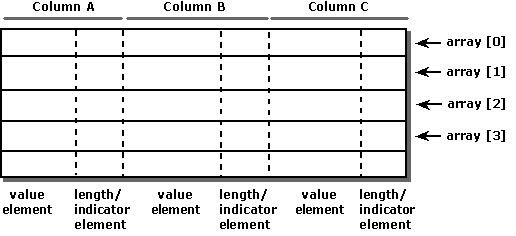El enlace
Cuando se usa un enlace de fila, una aplicación define una estructura que contiene una o dos, o en algunos casos tres elementos para cada columna para la que se van a devolver los datos. El primer elemento contiene el valor de datos y el segundo elemento contiene el búfer de longitud o indicador. Los indicadores y los valores de longitud se pueden almacenar en búferes independientes estableciendo los campos de descriptor de SQL_DESC_INDICATOR_PTR y SQL_DESC_OCTET_LENGTH_PTR en valores diferentes; si esto se hace, la estructura contiene un tercer elemento. A continuación, la aplicación asigna una matriz de estas estructuras, que contiene tantos elementos como hay filas en el conjunto de filas.
La aplicación declara el tamaño de la estructura al controlador con el atributo de instrucción SQL_ATTR_ROW_BIND_TYPE y enlaza la dirección de cada miembro en el primer elemento de la matriz. Por lo tanto, el controlador puede calcular la dirección de los datos de una fila y columna determinada como
Address = Bound Address + ((Row Number - 1) * Structure Size)
donde las filas se numeran de 1 al tamaño del conjunto de filas. (Se resta uno del número de fila porque la indexación de matriz en C está basada en cero). En la ilustración siguiente se muestra cómo funciona el enlace de fila. Por lo general, solo las columnas que se enlazarán se incluyen en la estructura. La estructura puede contener campos que no están relacionados con las columnas del conjunto de resultados. Las columnas se pueden colocar en la estructura en cualquier orden, pero se muestran en orden secuencial para mayor claridad.

Por ejemplo, el siguiente código crea una estructura con elementos en los que devolver datos para las columnas Identificación de pedido, Comercial y Estado, y longitudes/indicadores para las columnas Comercial y Estado. Asigna 10 de estas estructuras y las enlaza a las columnas Identificación de pedido, Comercial y Estado.
#define ROW_ARRAY_SIZE 10
// Define the ORDERINFO struct and allocate an array of 10 structs.
typedef struct {
SQLUINTEGER OrderID;
SQLINTEGER OrderIDInd;
SQLCHAR SalesPerson[11];
SQLINTEGER SalesPersonLenOrInd;
SQLCHAR Status[7];
SQLINTEGER StatusLenOrInd;
} ORDERINFO;
ORDERINFO OrderInfoArray[ROW_ARRAY_SIZE];
SQLULEN NumRowsFetched;
SQLUSMALLINT RowStatusArray[ROW_ARRAY_SIZE], i;
SQLRETURN rc;
SQLHSTMT hstmt;
// Specify the size of the structure with the SQL_ATTR_ROW_BIND_TYPE
// statement attribute. This also declares that row-wise binding will
// be used. Declare the rowset size with the SQL_ATTR_ROW_ARRAY_SIZE
// statement attribute. Set the SQL_ATTR_ROW_STATUS_PTR statement
// attribute to point to the row status array. Set the
// SQL_ATTR_ROWS_FETCHED_PTR statement attribute to point to
// NumRowsFetched.
SQLSetStmtAttr(hstmt, SQL_ATTR_ROW_BIND_TYPE, sizeof(ORDERINFO), 0);
SQLSetStmtAttr(hstmt, SQL_ATTR_ROW_ARRAY_SIZE, ROW_ARRAY_SIZE, 0);
SQLSetStmtAttr(hstmt, SQL_ATTR_ROW_STATUS_PTR, RowStatusArray, 0);
SQLSetStmtAttr(hstmt, SQL_ATTR_ROWS_FETCHED_PTR, &NumRowsFetched, 0);
// Bind elements of the first structure in the array to the OrderID,
// SalesPerson, and Status columns.
SQLBindCol(hstmt, 1, SQL_C_ULONG, &OrderInfoArray[0].OrderID, 0, &OrderInfoArray[0].OrderIDInd);
SQLBindCol(hstmt, 2, SQL_C_CHAR, OrderInfoArray[0].SalesPerson,
sizeof(OrderInfoArray[0].SalesPerson),
&OrderInfoArray[0].SalesPersonLenOrInd);
SQLBindCol(hstmt, 3, SQL_C_CHAR, OrderInfoArray[0].Status,
sizeof(OrderInfoArray[0].Status), &OrderInfoArray[0].StatusLenOrInd);
// Execute a statement to retrieve rows from the Orders table.
SQLExecDirect(hstmt, "SELECT OrderID, SalesPerson, Status FROM Orders", SQL_NTS);
// Fetch up to the rowset size number of rows at a time. Print the actual
// number of rows fetched; this number is returned in NumRowsFetched.
// Check the row status array to print only those rows successfully
// fetched. Code to check if rc equals SQL_SUCCESS_WITH_INFO or
// SQL_ERRORnot shown.
while ((rc = SQLFetchScroll(hstmt,SQL_FETCH_NEXT,0)) != SQL_NO_DATA) {
for (i = 0; i < NumRowsFetched; i++) {
if (RowStatusArray[i] == SQL_ROW_SUCCESS|| RowStatusArray[i] ==
SQL_ROW_SUCCESS_WITH_INFO) {
if (OrderInfoArray[i].OrderIDInd == SQL_NULL_DATA)
printf(" NULL ");
else
printf("%d\t", OrderInfoArray[i].OrderID);
if (OrderInfoArray[i].SalesPersonLenOrInd == SQL_NULL_DATA)
printf(" NULL ");
else
printf("%s\t", OrderInfoArray[i].SalesPerson);
if (OrderInfoArray[i].StatusLenOrInd == SQL_NULL_DATA)
printf(" NULL\n");
else
printf("%s\n", OrderInfoArray[i].Status);
}
}
}
// Close the cursor.
SQLCloseCursor(hstmt);
Comentarios
Proximamente: Ao longo de 2024, retiraremos gradualmente GitHub Issues como mecanismo de comentarios sobre o contido e substituirémolo por un novo sistema de comentarios. Para obter máis información, consulte: https://aka.ms/ContentUserFeedback.
Enviar e ver os comentarios